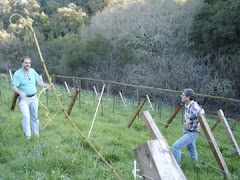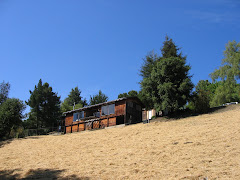
February 20, 2008
An acre, from the Old English for an "open field", is defined as the amount of land that is tillable by one man with an ox drawn plow in one day. Well, I could have used that ox this last week! I had trouble finding someone willing to disc our field this early in the season. And although the weather has been pretty dry for last couple of weeks, it is dangerous to operate a wheeled tractor on a slick hillside. What I needed was a "crawler tractor" with treads like a tank, but the few tractor services around here were unable or not willing to start this early. As I was panicking about what I could do, I actually found a community college professor in Marin County who plows his own fields with his team of Clydesdale horses (holy Budweiser!), but the logistics of moving his team of horses was not possible.
Finally, I found a "Ditch-Witch" crawler tractor with a 48" wide rototiller attachment (see picture above) and just before the rains of this last Tuesday, I was able to rototill our field, which begs the question, why do we till or plow. According to one source, "plowing prepares a seed bed, controls weeds, turns under crop residues, weeds, composts organic matter into the soil. In, addition, plowing helps regulate soil ventilation, moisture, temperature, and makes plant food more readily available to the planted crop." That's a mouthful!
Some 5000 years ago some prehistoric farmer got the idea of hitching his ox to his digging stick. Primitive stick plows still are used in some parts of the world. The ancient Romans shod the point with iron or bronze to protect it from wear. The Dutch improved the Roman plow, who needed a different shape for their soils. The colonial plow was a heavy wooded & wrought iron 10' long beam. It took several teams of horses or oxen to pull it & often needed repairs. In 1797, a plow of solid cast iron was patented in New Jersey & soon after Thomas Jefferson invented one which could be pulled more easily. In the western expansion of North America, this plow could not successfully break the tough sod formed by the matted roots of the prairie grasses. Even with 5-10 oxen pulling, the sticky black soil clung to the plow and had to be scraped off every few steps. John Lane made a plow with polished steel circular saw blade which would "scour" the soil off the plough without cleaning (what we know as discing today). In 1837, John Deere, a blacksmith of Grand Detour, Illinois, made further improvements and founded the now famous farm implement company.
But plowing, on the other hand, releases a lot of carbon into the atmosphere, so there is a big movement in the farming community to sequester greenhouse gases from the atmosphere by plowing as little as possible increasing the carbon content of the soil. This is probably the last time we will turn the soil in the vineyard. After we plant we will propagated specific species of native grasses that act as ground cover around the grapevines and only "weed-wack" them down seasonally.
One more thing to do before we plant and that is to get the trellis set up and we will discuss that next week!
Regards, John
One more thing to do before we plant and that is to get the trellis set up and we will discuss that next week!
Regards, John





























































































































No comments:
Post a Comment